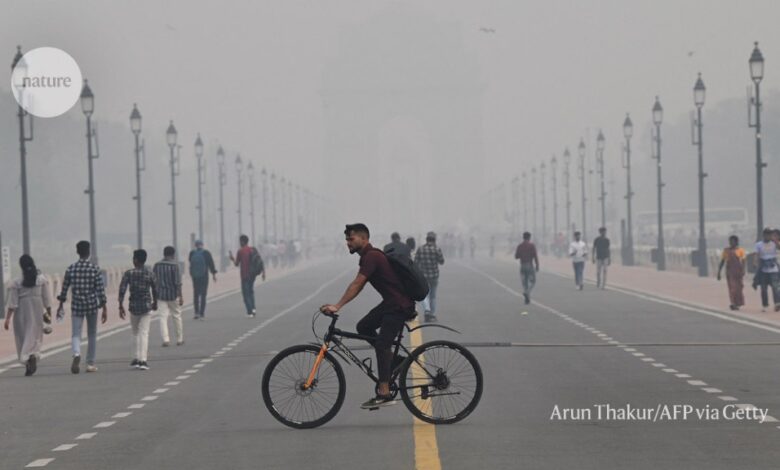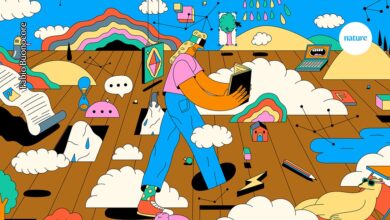
As the Hindu festival of Diwali kicks off on 10 November, the Indian capital of Delhi, already blanketed in choking smog, is bracing for pollution to worsen. Over the past week, children struggling to breath the acrid air have flooded hospital emergency departments, and schools have been forced to close. Why is Delhi’s air pollution so bad right now?
Since 3 November, the air quality index (AQI) — a measure of eight pollutants, including fine particulate matter, ozone and sulfur dioxide — in Delhi has remained consistently above 99. Anything above 150 is classified as unhealthy. On 6 November, the AQI surpassed 500, the top of the scale.
The city’s daily concentration of fine particles less than 2.5 micrometres in diameter (PM2.5) — which can enter the bloodstream, leading to poor health — remained above 200 micrograms per cubic metre between 3 November and 9 November. World Health Organization (WHO) guidelines recommend concentrations stay below an average of 15 micrograms per cubic metre over 24 hours.
But although Delhi’s air is attracting attention now, scientists say that the spike is actually typical for this time of year. The post-monsoon season, which lasts from October to December, delivers an annual pollution bomb to Delhi, a megacity of more than 30 million people. Other cities in India are also plagued by poor air quality at this time of year.
“Every year it is a similar story,” says Vinayak Sinha, an atmospheric chemist at the Indian Institute of Science Education and Research Mohali.
Concentrated pollutants
Sinha says that atmospheric conditions after the monsoon exacerbate pollution. Rainfall that washes pollutants out of the air during the monsoon ceases. As temperatures fall, the upper boundary of the troposphere — the lowest layer of atmosphere — drops in altitude and the troposphere shrinks. That causes the soup of pollutants in the troposphere to become more concentrated, says Sinha. “You have a smaller container now into which your air emissions are being stored,” he says.
Even so, current conditions came as something of a surprise, says Karthik Ganesan, a policy researcher at the Council on Energy Environment and Water in New Delhi. That’s because the amount of crop waste burnt in the neighbouring Punjab region was lower than usual this year, causing some people to expect a milder increase in pollution.
But as it turned out, air quality was as poor as ever because of changing meteorological conditions, including drops in wind speed on certain days. When wind speed falls, the air stagnates, trapping local emissions and leading to a pollution spike, says Ganesan.
Fires and fireworks
The change in weather also triggers behaviour that boosts emissions, says Sinha. More people burn fires in landfill once the monsoon rains have stopped; construction activities pick up; and, outside the city, farmers burn post-harvest crop waste in preparation for new planting.
A 2019 study found that 42% of the black carbon — a pollutant that contributes to haze formation and affects health — in Delhi in winter and autumn was from crop burning1. Another study estimated that on average, 20% of PM2.5 in Delhi during the post-monsoon season was from crop fires, but that could peak to 50–75% on severe days2.
Fireworks set off to celebrate Diwali this weekend will add to the pollution, says Ganesan, and will cause a rise in levels of the harmful metal ions that give the fireworks their colour.
But Ganesan says that even everyday emissions in the city are enough to create a “toxic cocktail”. Vehicle emissions, as well as those from inefficient household fuels such as firewood, produce large amounts of air pollutants, he says.
“The problem is year round,” says atmospheric scientist Sarath Guttikunda, director of Urban Emissions, a non-governmental research institute in Goa, India.
What can be done?
For a week starting on 13 November, Delhi will implement restrictions on vehicles. The ‘odd–even rule’ means that between 8 a.m. and 8 p.m., only vehicles with number plates ending in odd numbers can drive on odd-numbered dates, and only those with number plates ending in even numbers can drive on even dates.
But Sinha says that such mandates have limited impact because motorcycles — which often produce more pollution than cars — are exempt from the mandate, so many people switch to driving them. Meanwhile, car drivers leave for work before 8 a.m. and depart after 8 p.m. to avoid the ban. That leads to especially bad pollution concentrations at these times, says Sinha, because the troposphere is already shallow owing to low night-time temperatures.
In 2021, the government installed a smog tower in Delhi’s main business district. These structures are intended to reduce pollution through the use of air filters. But Sinha says that they don’t have much impact. “They shouldn’t be used at all,” he says. Air filters work in confined spaces indoors, but “if you talk of the open atmosphere, there is no way that any smog tower in the world is actually able to clean it”, he says.
Ganesan says that effective solutions will require reductions in multiple sources of emissions. He says that governments at all levels need to make clean air a priority — by, for example, improving public transport and waste collection, and ensuring that people have access to clean fuel for cooking and heating. “We can’t be looking at [the problem] for just six weeks” each year, he says.
Source link




